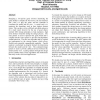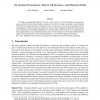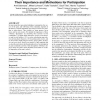132 search results - page 5 / 27 » Identifying Bullies with a Computer Game |
SIGCSE
2002
ACM
13 years 8 months ago
2002
ACM
Designing a two-person game involves identifying the game model to compute the best moves, the user interface (the "view") to play the game, and the controller to coordi...
STACS
2010
Springer
14 years 3 months ago
2010
Springer
We study computational problems that arise in the context of iterated dominance in anonymous games, and show that deciding whether a game can be solved by means of iterated weak d...
CHI
2011
ACM
13 years 3 days ago
2011
ACM
This work explores the intersection between infographics and games by examining how to embed meaningful visual analytic interactions into game mechanics that in turn impact user b...
ACMACE
2005
ACM
14 years 2 months ago
2005
ACM
In many game-like open-ended multiplayer communities, the success of the game, and well-being of the community, depends on the efforts of certain individuals who arrange resources...
MP
2006
13 years 8 months ago
2006
We present a distribution-free model of incomplete-information games, both with and without private information, in which the players use a robust optimization approach to contend ...



